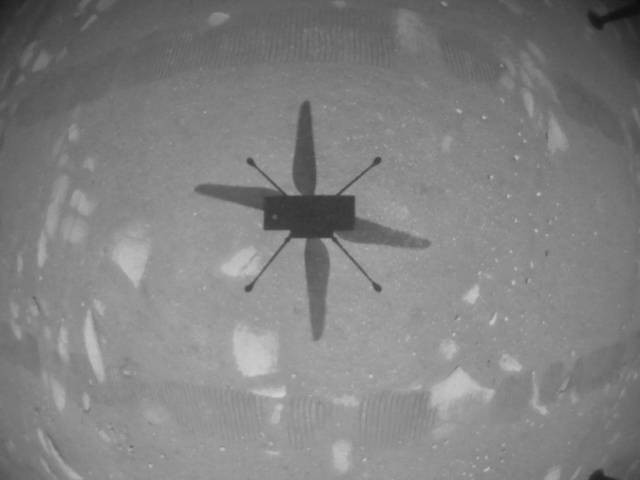NASA achieved history with Ingenuity on Monday, April 19, 2021, when it conducted the first controlled flight of an aircraft on Mars. NASA confirmed that the little helicopter steadily climbed to a height of three meters (9.8 feet) above the surface of Mars, hovered for 30 seconds, and then fell to land on its four legs, according to onboard data and photographs provided through strong X-band communications.

NASA’s Ingenuity Mars Helicopter captured this shot as it hovered over the Martian surface on April 19, 2021, during the first instance of powered, controlled flight on another planet. It used its navigation camera, which autonomously tracks the ground during flight.
NASA Ingenuity Helicopter Shares Longest, Fastest Flight Yet
Since then, the mini-helicopter has made several flights on Mars, and it continues to set new marks. Ingenuity's black-and-white navigation camera-generated excellent video footage of its record-breaking 25th trip, NASA revealed in a news release on Friday. The helicopter covered a distance of 704 meters (2,310 feet) at a speed of 5.5 meters per second during the event, which took place on April 8. (12 mph).
Overall, it was the longest and quickest flight of the Red Planet rotorcraft.
The video clip, shared on YouTube, begins roughly one second into the flight and reveals fantastic images. When the aircraft starts to go southwest while accelerating to its maximum speed in less than three seconds, Ingenuity can reach a height of 10 meters (33 feet).
Although the film is in black and white, the collection of sand ripples that arise approximately halfway through the clip and that Ingenuity hovers above can clearly be seen.
An aerial view from Mars.
— NASA JPL (@NASAJPL) May 28, 2022
During #MarsHelicopter’s 25th flight, it flew 2,310 ft (704 m) at a speed of 12 mph (5.5 m/s), breaking its own distance and groundspeed records on another planet. Imagery recently downlinked shows Ingenuity’s point of view. https://t.co/NU5d6wGSdE pic.twitter.com/IqgkEmR04W
ALSO READ: NASA to Give Updates on InSight Mission After Lander Continues to Struggle From Mars Dust
The helicopter will continue to fly until it finds reasonably level and featureless territory on which to land. The flight lasted 161.3 seconds in total, but the film was sped up five times, bringing it down to less than 35 seconds.
Landing Spot
Finally, the landscape was generally level and featureless, making for a decent landing place. Reports said the 161.3-second trip was sped up by around five times, bringing it down to less than 35 seconds.
The navigation camera is set to turn off anytime the rotorcraft is within 3 feet (1 meter) of the ground. It ensures that any dust stirred up during takeoff and landing does not interfere with the navigation system's tracking of ground features.
The navigation camera is set to turn off anytime the rotorcraft is within 1 meter (3 feet) of the ground, ensuring that any dust stirred up during takeoff and landing does not interfere with the navigation system.
Ingenuity is a self-flying spacecraft that communicates with Earth via numerous routes. It first communicates with a Mars Perseverance rover's helicopter base station. The data is subsequently transmitted by the rover to NASA's Deep Space Network (DSN) satellites through the Mars Reconnaissance Orbiter (MRO). Finally, the DSN transmits the data to NASA's Jet Propulsion Laboratory (JPL) in California.
RELATED ARTICLE: NASA Ingenuity Helicopter Captures Bizarre Image of Conical Spacecraft Wreckage That Remained Intact Despite Mars' Stressful Atmosphere
Check out more news and information on Space in Science Times.










!['Cosmic Glitch' in Einstein's Theory of General Relativity Could Be Explained in This New Scientific Tweak [Study]](https://1721181113.rsc.cdn77.org/data/thumbs/full/53435/258/146/50/40/cosmic-glitch-in-einsteins-theory-of-general-relativity-could-be-explained-in-this-new-scientific-tweak-study.jpeg)



